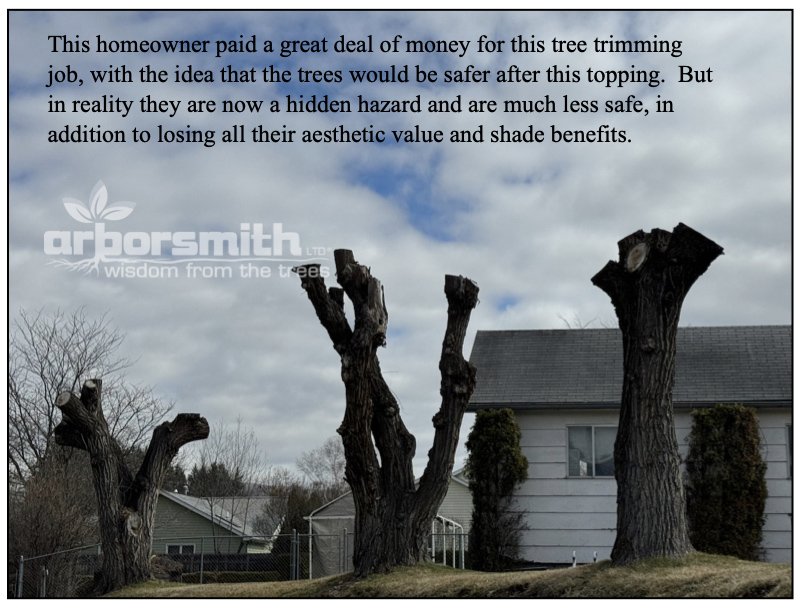Tree Topping, a practice that must stop!!
Fifty years ago, as young urban foresters, we were taught that cutting the tops out of trees made them much safer. After much research and harrowing experience, we have learned quite the opposite. Tree topping actually weakens trees and makes them more hazardous as time goes by, even if they look safer. If you would like to know why, please listen with us, to the wisdom of the trees.
Photos by Gilbert and Lesley Smith
When you cut a tree, it is easy to think you are reducing its size, but you are actually telling the tree to grow bigger, from the place where it was cut. This is because trees are regulated by some remarkable hormones called Auxins, that trigger them to grow in healthy, structurally strong ways. When the branch ends are cut, the Auxins are thrown out of balance, signaling an emergency response to the trimming injury. This growth response causes the branch tips to explode into multiple, undirected or misdirected shoots. BOOM! Just the opposite of what most people expect.
That explosion of shoots at the branch tips not only causes the tree to get bigger, it also causes a confusion of branches that are weakly attached to each other and the main stem. As these branches grow, the danger from breakage increases, significantly. This is the tree’s response to damage, as for instance, when a storm damages the tree tops. The tree is working to recover by getting out there to get as much sun exposure on its leaves=its food producers as possible to feed itself. Don’t forget that trees get their food from the sun. The tree has to survive in the short run, even if it may cut the safe life of the tree short.
On top of all that, this tree topping has caused weak, rotting spots from which all of the new branches arise. A long singular, circular branch is a very strong structure, surprisingly by weight even stronger than steel! But now, not only does wood rot set in where the branch was cut, but the break in structure acts as a fulcrum for branch failure. The longer the branches get, the more strain is put on that weak, rotting fulcrum point. It is a recipe for future tree failure.
So the question now is what do we do if the tree has become dangerously weak and is threatening our house, or what if it is just too big? What about if you just love this old tree with all its imperfections? These are tough questions for many reasons.
Now is the time to call in a Certified Arborist making sure they are certified by the International Society of Arboriculture and not just someone who wants to make money taking your tree out or worse, topping it again. Ask around for referrals and check their website. ALL ISA Certified Arborists brag about this accreditation, it is not easy to obtain or maintain and is a very minimum requirement for a competent and qualified arborist.
Many times when we are called out to evaluate tree safety, the tree in question is healthy, beautiful and strong. No need to worry, just have it inspected regularly and enjoy it. Often, however, the trees that no one worries about are, unexpectedly, the ones that pose a real threat. We hate to say it, but until a tree fails or falls most people don’t look up. If they do look up, they often don’t know what hazards to look for.
The very best advice we can give you is to plant your trees where they can grow and prosper without hitting your house or the power lines. This requires some thinking and research into a tree’s ultimate genetic size and growing requirements. Try to avoid the impulsive purchase of trees on sale at the local garden center or big box store unless you know what you want and have a pretty good idea what you are looking for as far as structure, growing requirements, and placement on your property. Don’t worry, we have all engaged in impulse purchases and sometimes we accidentally make a happy and successful decision. More often though, we create a costly hazard down the road that we regret.
Right now, you need an honest evaluation of the safety of your trees by someone who knows what they are looking at. If it is deemed unsafe, perhaps you can mitigate the dangers with cables or careful reduction pruning. But remember that you need to continue to monitor your tree’s safety with regular inspections by a qualified professional. When your arborist says it’s time…remember to thank your tree for all of its years of beautiful service and then to let it go with gratitude.
And one more thing: when you remove a tree, try to replant with one or two replacements. Ask your Forester or Arborist for a plan or suggestions for replanting. A little extra expense on the front end can save costly mistakes later on. Arborsmith loves to do this kind of consulting and after 50 years of working with trees we are pretty good and giving good advice.



